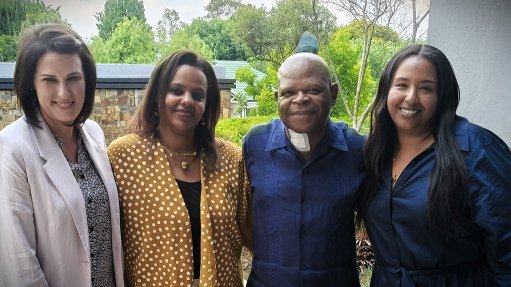Green hydrogen potential hinges on collaboration, more standards – SANEDI
South African National Energy Development Institute (SANEDI) renewable energy project manager Dr Karen Surridge says South Africa has a unique opportunity to participate in the global shift towards sustainable energy by developing a domestic green hydrogen sector.
She states in an opinion piece that the country’s considerable renewable resources can be used for economic, environmental and social benefits and that a green hydrogen industry can facilitate increased infrastructure development, rural development, energy security, economic diversification and sustainability.
The key to unlocking this potential is collaboration, Surridge emphasises.
She adds that the country has the potential to be a key player in the green hydrogen economy and could possibly capture 10% of the global export market share.
“To bring green hydrogen to market at scale and turn South Africa’s abundant potential into reality, fostering direct engagement and communication between stakeholders across the green hydrogen economy is crucial.
“This requires aligning policies, regulations and research and development around the role of green hydrogen. It also includes leveraging existing resources and encouraging the launch of local commercial manufacturers of, among others, fuel cells and electrolysers through various modalities including public-private partnerships.”
Moreover, the green hydrogen sector will have a direct socioeconomic impact and support the government in achieving the objectives outlined by various national commitments, including the country’s Nationally Determined Contribution, the Just Energy Transition Investment Plan and the Integrated Resource Plan.
Surridge notes that the green hydrogen value chain can be divided into three core segments: upstream activity, which deals with the production process; midstream activity, which includes the transformation and transportation of hydrogen; and downstream activity, which involves the distribution and end-usage of hydrogen.
The development of South Africa's role in the global green hydrogen market hinges on establishing supportive policies and regulatory frameworks across the value chain.
Currently, there is a need for standards for hydrogen processes. While the Occupational Health and Safety Act of 1993 provides some regulatory oversight, it lacks specificity for hydrogen, and the Gas Act of 2001 excludes hydrogen owing to its non-hydrocarbon nature.
However, the Hydrogen Society Roadmap underscores the importance of regulations, codes and standards in the green hydrogen value chain.
Existing regulations and standards for hydrogen distribution, storage, and utilisation beyond factory gates, including for emerging applications such as fuel cell electric vehicles and hydrogen refuelling stations, will need to be further developed.
“Identifying the value chain elements that offer the greatest feasible potential for local development and production is essential, which can ultimately reduce the production cost of green hydrogen locally,” Surridge says.
Commenting on the export component, Surridge highlights an important focus area as being the certification of green hydrogen and its derivatives.
Therefore, the next crucial step in the implementation process will be to create coordinated research agendas targeting South Africa’s strengths in the sector. This involves engaging with commercial companies and research institutions to ensure that research and development (R&D) are aligned, and focused on actions and policies required to unlock key opportunities for the country.
This will require deepening the collaboration between the public sector, private sector, academia and industry associations.
Should local R&D not be able to demonstrate technologies commercially, the industry will import what it needs, and this opportunity would be lost. However, it is important to remember that resources should focus on the strengths of South Africa to accelerate the sector’s development, Surridge notes.
One solution she suggests is creating demonstration hubs or technology or innovation parks where companies can engage with industry and research institutions.
RATIONALE
Green hydrogen, when fully integrated, can be a sustainable and versatile energy source that can help address climate change and promote the use of renewable energy.
It can potentially displace some fossil fuel use, decrease greenhouse-gas emissions and contribute to a more sustainable future.
By 2050, green hydrogen is anticipated to meet 12% of the world's energy needs, driven mainly by markets including the EU, the US, China, South Korea, Japan and the Middle East.
Transitioning to green hydrogen can also provide benefits to local communities.
The shift to green hydrogen can positively impact local community development projects and improve living standards by providing better energy access and subsequent job opportunities. This is expected to lead to the development of skills and capacity building in new green technologies.
“Green hydrogen represents a significant opportunity for South Africa to take a step towards sustainable energy and create possibly substantial economic opportunities,” Surridge concludes.
Article Enquiry
Email Article
Save Article
Feedback
To advertise email advertising@creamermedia.co.za or click here
Press Office
Announcements
What's On
Subscribe to improve your user experience...
Option 1 (equivalent of R125 a month):
Receive a weekly copy of Creamer Media's Engineering News & Mining Weekly magazine
(print copy for those in South Africa and e-magazine for those outside of South Africa)
Receive daily email newsletters
Access to full search results
Access archive of magazine back copies
Access to Projects in Progress
Access to ONE Research Report of your choice in PDF format
Option 2 (equivalent of R375 a month):
All benefits from Option 1
PLUS
Access to Creamer Media's Research Channel Africa for ALL Research Reports, in PDF format, on various industrial and mining sectors
including Electricity; Water; Energy Transition; Hydrogen; Roads, Rail and Ports; Coal; Gold; Platinum; Battery Metals; etc.
Already a subscriber?
Forgotten your password?
Receive weekly copy of Creamer Media's Engineering News & Mining Weekly magazine (print copy for those in South Africa and e-magazine for those outside of South Africa)
➕
Recieve daily email newsletters
➕
Access to full search results
➕
Access archive of magazine back copies
➕
Access to Projects in Progress
➕
Access to ONE Research Report of your choice in PDF format
RESEARCH CHANNEL AFRICA
R4500 (equivalent of R375 a month)
SUBSCRIBEAll benefits from Option 1
➕
Access to Creamer Media's Research Channel Africa for ALL Research Reports on various industrial and mining sectors, in PDF format, including on:
Electricity
➕
Water
➕
Energy Transition
➕
Hydrogen
➕
Roads, Rail and Ports
➕
Coal
➕
Gold
➕
Platinum
➕
Battery Metals
➕
etc.
Receive all benefits from Option 1 or Option 2 delivered to numerous people at your company
➕
Multiple User names and Passwords for simultaneous log-ins
➕
Intranet integration access to all in your organisation





















